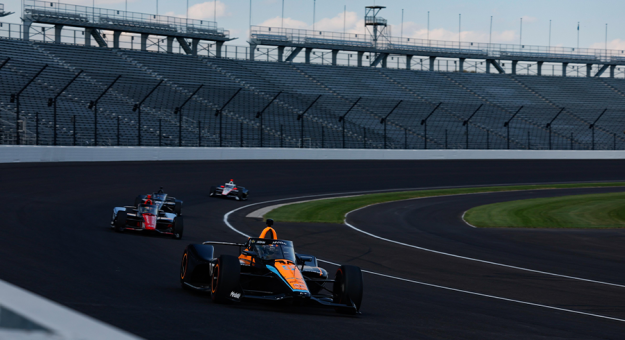INDIANAPOLIS — As expected, the debut of IndyCar’s hybrid assist unit will be at the July 5-7 Honda Indy 200 at Mid-Ohio weekend. That means the second half of the 2024 NTT IndyCar Series season will be completed with the addition of the hybrid assist device to the current Chevrolet and Honda internal combustion engines.
IndyCar, Chevrolet, and Honda have worked in collaboration to develop the first-of-its-kind hybrid unit. The 2.2-liter, twin-turbocharged V-6 engine was initially paired and tested with hybrid power Aug. 16, 2023, at Sebring International Raceway.
In just seven months, a total of 23,518 miles were successfully completed among 28 NTT IndyCar Series drivers.
“The strength of this uncharted partnership between Chevrolet and Honda has pushed this innovative project to the grid in 2024,” IndyCar President Jay Frye said. “The IndyCar-specific hybrid power unit will bring a new and exciting element to the NTT IndyCar Series with additional energy and overtake options. We cannot wait to see the start of this new era at Mid-Ohio.”
IndyCar’s hybrid power expands the series’ efforts to deliver the most competitive motorsport
on the planet. The new powerplant unit will feature additional overtake (Push to Pass) options, ultimately giving IndyCar Series drivers more choices and control – enhancing the on-track competition and excitement.
The innovative hybrid system is made up of the low voltage (48V) Motor Generator Unit (MGU) and Energy Storage System (ESS) – consisting of 20 ultracapacitors – both of which fit inside the bellhousing, located between the Chevrolet and Honda IndyCar Series internal combustion engine and the gearbox.
During regeneration, acting on the clutch shaft, the MGU builds power to be stored in the ESS. The additional horsepower is deployed through the same motor generator on driver demand.
For competition, options for automatic “regen” via braking or throttle position and manual “regen” via selected steering wheel paddles and buttons will be available. Deployment of stored energy will only be available manually through a latching button, similar to the existing Push to Pass system.
While available to use in addition to the traditional IndyCar Push to Pass system on road and street circuits, the two systems will come with different rules. Push to Pass will still have a restriction on amount of time per use and total time used over the course of a race. Rules for the
hybrid power unit will limit the amount of energy deployed per lap – based on track length. Used
in combination on road and street circuits, the added boost will provide an additional 120horsepower for a total of 800+ for the first time in two decades. Additional horsepower is expected in the coming years as hybrid unit development evolves.
Safety elements include the low voltage system and the ability for drivers to restart the car by themselves if they spin and stall the engine on the track – avoiding the need for the AMR IndyCar Safety Team to be deployed and creating more green-flag action in races.
“The introduction of hybrid technology provides an opportunity to integrate electrification technologies into the NTT IndyCar,” General Motors Executive Director, Motorsports Competition Eric Warren said. “During the development of any new technology, extensive analysis and testing are done to identify as many issues as possible.
“We support IndyCar’s decisions throughout this process to study testing data carefully and make sure that when the hybrid technology is integrated, the operation and performance are exactly what is expected.
“This approach has given IndyCar and the engine manufacturers the opportunity to ensure the high level of competition continues uninterrupted.”
“Hybrid technology is playing an ever-increasing role in both our racing programs and the production vehicles created by Honda and Acura,” Honda Racing Corporation USA President David Salters said. “More than a quarter of Honda’s total sales in 2023 – nearly 300,000 vehicles – were Honda CR-V and Accord hybrids. Introducing electrification to IndyCar at Mid-
Ohio further aligns our racing efforts with Honda’s passenger car production as we operate multiple manufacturing and R&D facilities in central Ohio, employing more than 13,000 associates there.
“This is exciting new technology and, like all things new, has presented challenges to us at HRC as we have stepped in with our competitors to help IndyCar make the hybrid system compact enough, powerful enough, light enough and reliable enough to work within the highly-restricted confines of an IndyCar chassis.
“We are proud of our associates’ work to develop the supercapacitor pack and control software for the system. We look forward to hybrid tech adding another dimension to the great racing spectacle and entertaining our great Honda and IndyCar racing fans.”
A full-field test of IndyCar’s power unit is scheduled for Tuesday, June 11 at The Milwaukee Mile to allow teams to finalize implementation ahead of the July debut. On-track testing has taken place at Barber Motorsports Park, Homestead-Miami Speedway road course, Indianapolis Motor Speedway, IMS road course, Milwaukee Mile, Road America, Sebring and World Wide Technology Raceway to effectively mirror the disciplines of the NTT IndyCar Series schedule.
